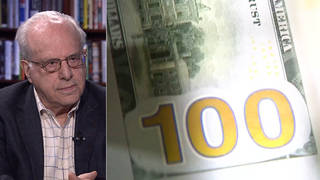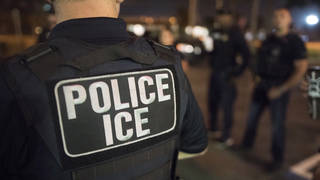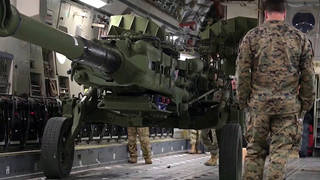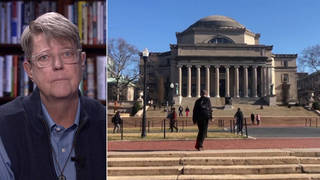
Guests
- William Hartungdirector of the Arms and Security Project at the Center for International Policy. His latest book is Prophets of War: Lockheed Martin and the Making of the Military-Industrial Complex.
Mikhail Kalashnikov, the inventor of the most popular firearm in the world, died Monday at the age of 94. The Kalashnikov assault rifle became one of the world’s most widely used weapons, with an estimated 100 million guns now spread worldwide. The relative simplicity of the Kalashnikov, or AK-47, made it cheap to produce, as well as reliable and easy to maintain. Kalashnikov designed his first machine gun in 1942 after suffering injuries as a tank commander for the Soviet Union’s Red Army during World War II. But it was only in 1947 after years of modification that the AK-47 was introduced for Soviet military service. In the early 1950s, the Kalashnikov became the standard weapon for Soviet and Warsaw Pact countries. The gun also proved popular with paramilitary groups. Although honored by the state, Kalashnikov made little money from his gun. He was often defensive about criticism that his invention had caused countless deaths around the world. We discuss the significance of the AK-47 and its maker with William Hartung, director of the Arms and Security Project at the Center for International Policy. Hartung’s latest book is “Prophets of War: Lockheed Martin and the Making of the Military-Industrial Complex.”
Transcript
AMY GOODMAN: The inventor of the most popular firearm in the world is dead. The Kalashnikov assault rifle, created by Mikhail Kalashnikov, became one of the world’s most widely used weapons. An estimated 100 million guns are spread worldwide. The relative simplicity of the Kalashnikov, or AK-47, made it cheap to produce, as well as reliable and easy to maintain.
Kalashnikov designed his first machine gun in 1942 after suffering injuries as a tank commander for the Soviet Union’s Red Army during World War II. But it was only in 1947, after years of modification, that the AK-47 was introduced for Soviet military service. In the early ’50s, the Kalashnikov became the standard weapon for Soviet and Warsaw Pact countries. The gun also proved popular with paramilitaries. Although honored by the state, Kalashnikov made little money from his gun. He was often defensive about criticism that his invention had caused countless deaths around the world. This is Kalashnikov speaking to the BBC.
MIKHAIL KALASHNIKOV: [translated] I created a weapon to defend the fatherland’s borders. It’s not my fault that it’s sometimes used where it shouldn’t have been.
AMY GOODMAN: Mikhail Kalashnikov died Monday at the age of 94. To talk about the significance of his weapon and its maker, we’re joined by William Hartung, director of the Arms and Security Project at the Center for International Policy. His latest book, Prophets of War: Lockheed Martin and the Making of the Military-Industrial Complex.
Welcome back to Democracy Now!
WILLIAM HARTUNG: Thanks for having me.
AMY GOODMAN: The significance of Mikhail Kalashnikov, Bill?
WILLIAM HARTUNG: Well, interesting character—didn’t have a high school education, grew up in South Siberia, rose up through the ranks because of his mechanical abilities. Not the only one who built this thing. It was a design bureau competing amongst 15 others. Stalin had a secret contest to build the next rifle for the Soviet army. Once they integrated it into the army, they started building it in large quantities, the Warsaw Pact countries, Soviet Union stockpiling them. Then they turned up in Vietnam, in Cuba, for the governments of Egypt and Iraq, and became sort of the firearm of the liberation movements in Southern Africa and, actually—
AMY GOODMAN: The Mozambican flag actually has an AK-47. It’s a bayonet attached to the barrel?
WILLIAM HARTUNG: Exactly.
AMY GOODMAN: On the flag?
WILLIAM HARTUNG: In honor of its use in the liberation movement, yes. ANC used them. And they were basically given away for free, and that’s why there are so many of them in the world now. It wasn’t really a market success; it was just the Soviet Union handing them out to any possible ally.
So what happened in Vietnam was it sort of made its reputation because the M-16, the U.S. rifle, was not working. It was jamming in the jungles. Any time a U.S. soldier could get a hold of an AK-47, he would throw out his M-16, use the AK-47, because it was more durable. You could use it in almost any condition. If it was dirty, it would work. And almost—you could do almost anything to these things. In fact, in Afghanistan, some of the Taliban members are using ones that are from the ’50s, that still operate 50 or 60 years later.
But we had this kind of a flip from the Cold War period where we had these huge stockpiles. And when the Soviet Union got out of the business of giving away weapons and became Russia, they became sort of fair game for people like Viktor Bout and other arms traffickers. What they did was they swapped resources with people like Charles Taylor for guns. And so you had this kind of business of war self-perpetuating. You didn’t need a client, and you didn’t need a country to back you up anymore. You could just steal resources, deal with arms dealers, as happened in the war in the Democratic Republic of Congo, as happened in Sierra Leone, civil war in Angola. So, because of its lightweight nature, the fact that it was cheap and ubiquitous, child soldiers were able to operate them without a logistics trail, very easy to maintain and use and so forth.
AMY GOODMAN: Let’s go back to Mikhail Kalashnikov talking about his invention.
MIKHAIL KALASHNIKOV: [translated] Weapons should only be in the hands of those people who defend their country—that is, to defend, not to attack. I designed the rifle not for international conflicts, but to protect the borders of my homeland.
AMY GOODMAN: That was Mikhail Kalashnikov. Can you talk about the Kalashnikov and its effect on the frequency and violence of war?
WILLIAM HARTUNG: Well, I think it’s an enabler of war. And what happens is, although the gun isn’t fighting the war itself, certainly the ability to kill so many people in such a short amount of time—600 rounds per minute—had never been possible in such a small killing package. And so, if you have a local dispute that’s settled with an AK-47, you’re going to have a war on your hands very shortly thereafter. So, in that sense, without the AK-47, perhaps we would have had political space to solve some of these conflicts. In the ’90s, the U.N. figured out that 46 of 49 conflicts was fought only with small arms, mostly with AK-47s.
AMY GOODMAN: Mikhail Kalashnikov was a lifelong member of the NRA. Let’s turn to comments made by the former president of the NRA, David Keene, explaining Kalashnikov’s membership.
DAVID KEENE: Some years ago, in Moscow, there was a dinner honoring General Kalashnikov. General Kalashnikov is the man who during the course of World War II, in his spare time, invented the AK-47. He’s one of the few heroes of Russia because of their flawed past. And so, on the occasion of his 85th birthday, there was a dinner honoring him in Moscow. The toast was given by President Putin. And when Putin finished, the general stood up, held his glass up in Putin’s face and said, “Mr. President, my dream is a country like the United States, governed by men and women not afraid of an armed populace.” We made General Kalashnikov an honorary life member of the National Rifle Association after that.
AMY GOODMAN: That’s David Keene, the former president of the National Rifle Association. The significance, Bill Hartung?
WILLIAM HARTUNG: It’s stunning even by NRA standards. Basically, they’re embracing the maker of this weapon that’s used by terrorists, used by tyrants, used by revolutionary movements—not a defensive weapon, as Kalashnikov claimed, but probably the biggest killing machine of the 20th century. So I think it just shows you how skewed the NRA view of the world is. And, in fact, they tried to block the Arms Trade Treaty, which is trying to deal with things like this, keep these weapons out of the hands of terrorists and tyrants. The NRA has used its global clout to try to water that down. They were unsuccessful in stopping it, but they’re going to try to blunt it at every turn.
AMY GOODMAN: Bill Hartung, we want to thank you for being with us, from the Center for International Policy. His latest book, Prophets of War.












Media Options